Climate control is one of the biggest reasons to upgrade from tent camping to RVing. Efficient, effective heating and cooling systems extend your camping season and makes your RV’s interior cozy and comfortable by simply adjusting the thermostat.
For many RVers, the thermostat goes unnoticed until it doesn’t function as anticipated. But a working knowledge of the thermostat can help you prevent issues and quickly identify the problem when something goes wrong. Whether you’re learning more about your RV or you’re having a specific issue, here’s everything you need to know about your RV thermostat.
What is an RV Thermostat?
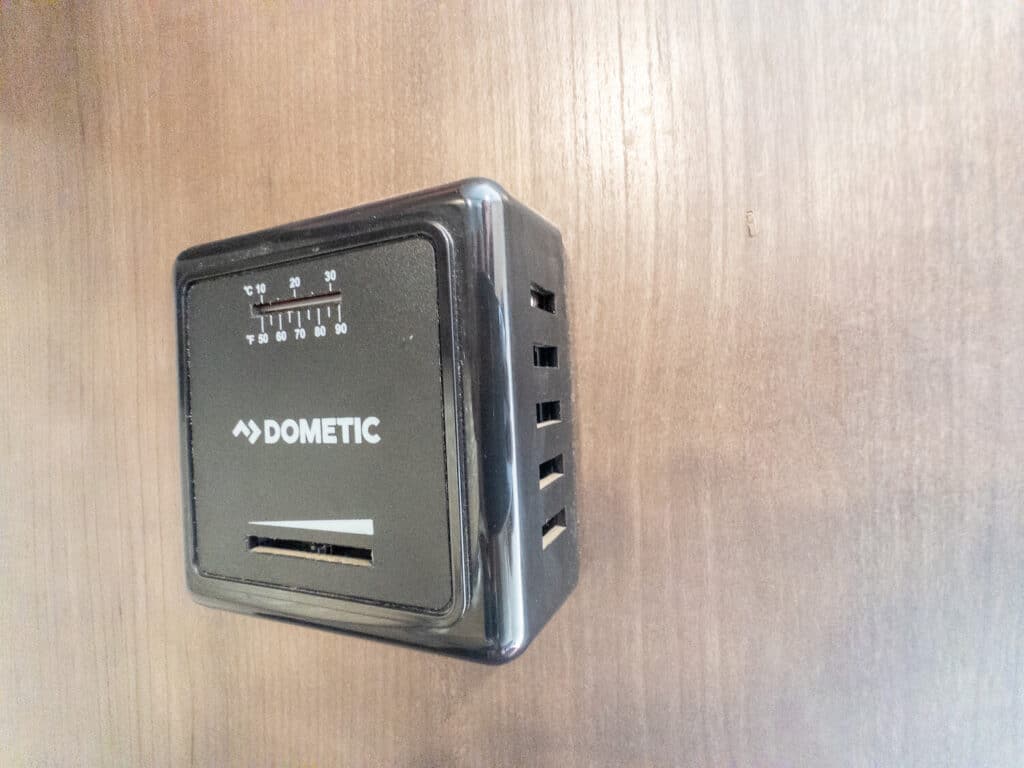
Photo by Camping World
Like those found in residential homes, RV thermostats regulate your RV’s interior temperature by controlling the operation of your heating and cooling systems, i.e., your furnace and air conditioner(s).
Depending on your RV’s design, you probably have multiple thermostats. Your air conditioner and furnace are the most common appliances that utilize a thermostat to control their operation, but RV refrigerators and water heaters have their own sensors for temperature control.
For the purposes of this article, we’ll focus on thermostats used in RV heating and cooling systems. Here are a couple of resources if you need to learn more about water heaters or refrigerators:
- How Do RV Water Heaters Work?
- RV Refrigerator Basics: Types, Buying Guide, and Maintenance
Are there Different Types of RV Thermostats?
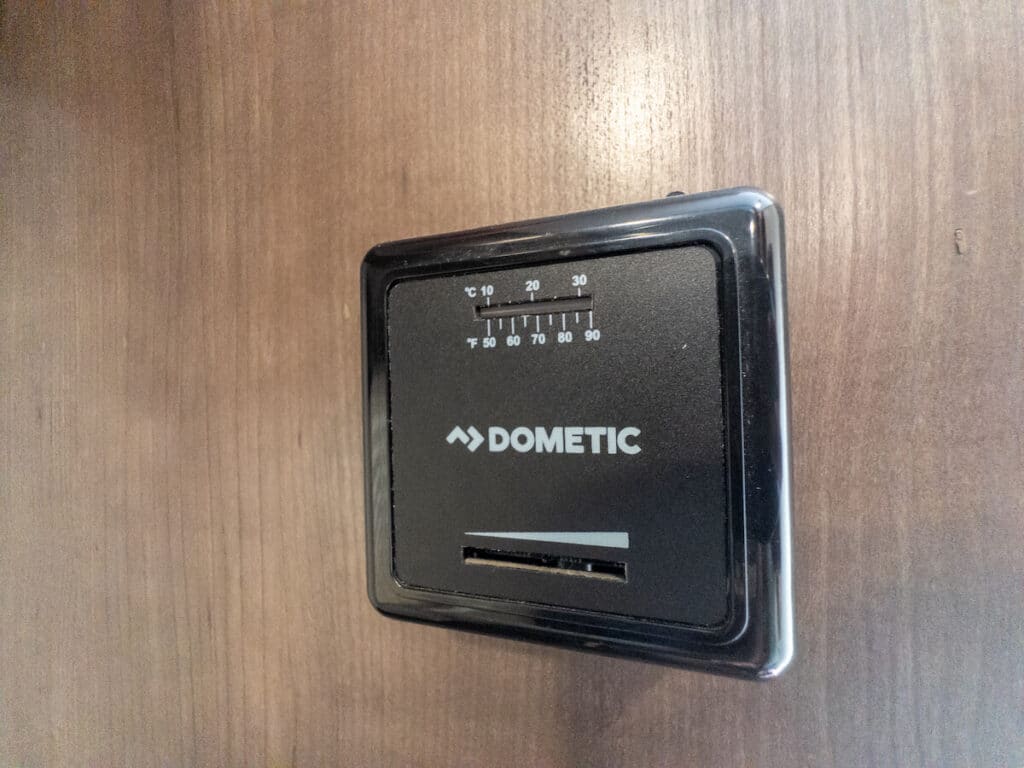
Furnace Thermostat
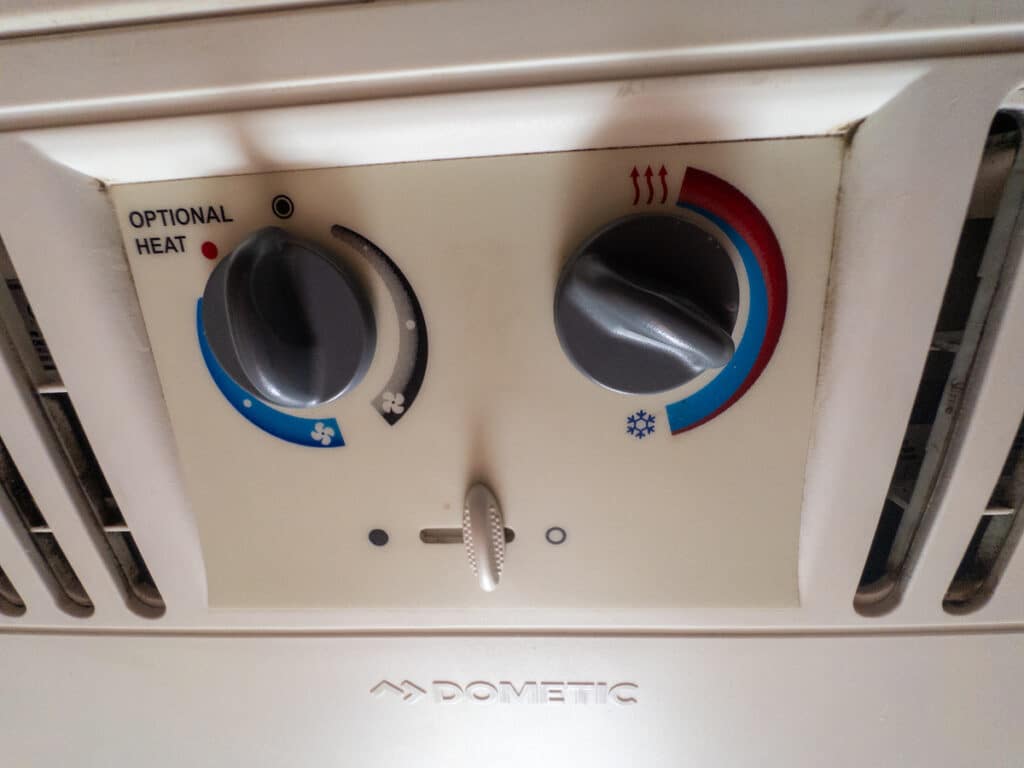
A/C Thermostat
The four main thermostats you’ll find in RVs are analog, digital, programmable, and smart thermostats.
- Analog thermostats are the simplest and most cost-effective to replace. Most analog designs are powered by your RV’s house battery. They utilize a heat-sensitive metal that bends when the temperature rises or falls.
- Digital thermostats are similar to those you’d find in a residential home. They use electrical temperature sensors to detect your RV’s temperature and then relay the results to the display so you can adjust settings accordingly.
- Programmable thermostats also fall into the digital category, but they allow you to schedule heating and cooling changes using preset temperature ranges. This helps you lower energy usage by only running your furnace or air conditioner when you’re inside your RV.
- Smart thermostats are digital, programmable options with modern features like Bluetooth connectivity. Most allow you to connect your smartphone to adjust your RV’s heating and cooling settings remotely.
What Do All RV Thermostats Have in Common?
From analog to smart, most RV thermostats require 12-volt DC power, which separates them from residential thermostats. At their core, they are basically a switch that turns your A/C or furnace on and off at specified temperatures.
Some get DC power from the control board in the air conditioner’s ceiling assembly and open or close the control power to a relay. These relays send 120-volt AC power to the air conditioning unit or DC power to the furnace. Some furnaces supply their own DC power to the thermostat, which simply opens or closes the furnace circuit. No RV furnaces utilize 120-volt AC power.
How Do I Reset My RV Thermostat?
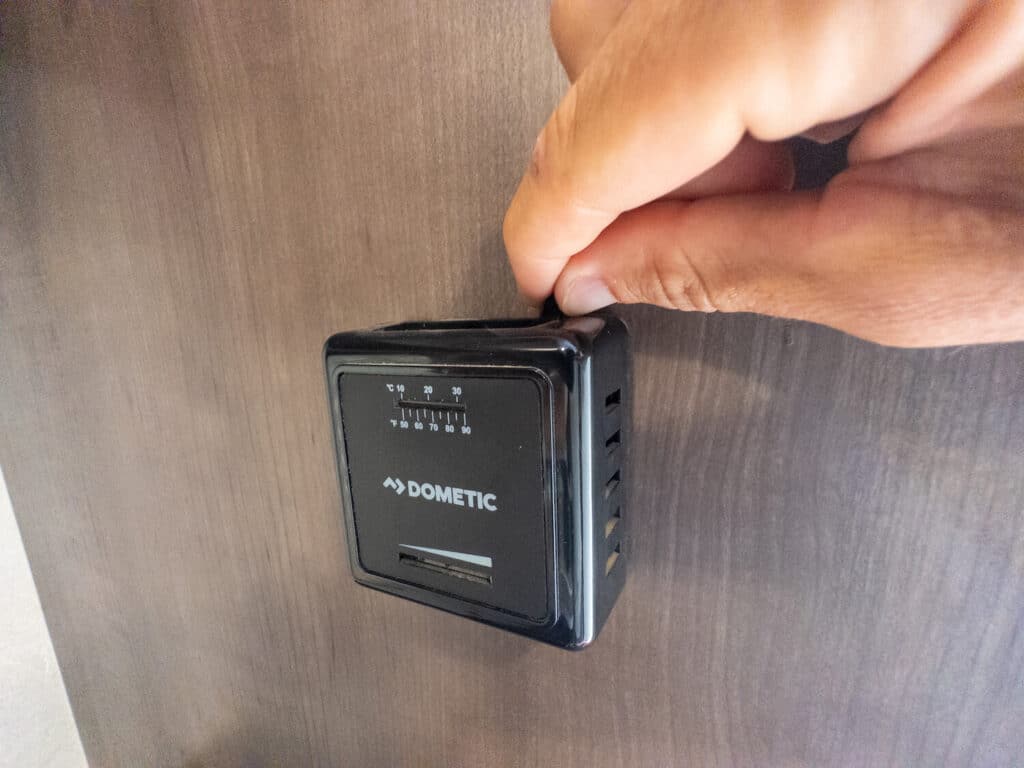
Photo by Camping World
If your thermostat isn’t working, it may need a simple reset. Try this before purchasing and installing a replacement RV thermostat. The exact process of resetting your thermostat depends on the manufacturer, but a reset generally requires the following three steps:
- Turn off the thermostat.
- Wait for the manufacturer’s recommended time period.
- Turn the thermostat back on.
With digital, programmable, and smart thermostats, a full reset may erase any preset ranges or climate control settings, so you may need to re-program your settings after a reset to ensure your RV’s heating and cooling systems work as desired.
How to Troubleshoot an RV Thermostat
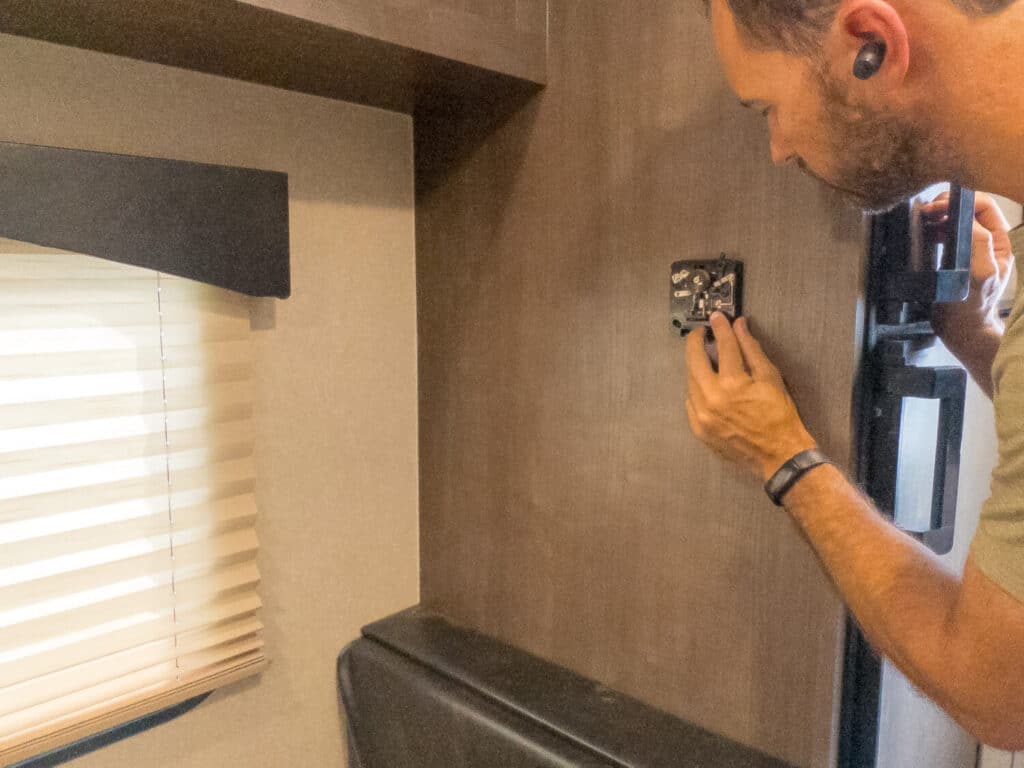
Photo by Camping World
On average, RV thermostats last 10-15 years. But how do you tell if yours has gone bad? The main issues that warrant an RV thermostat replacement include:
- The furnace or A/C runs continuously without cycling
- The set temperature doesn’t match your RV’s actual temperature
- The display is dim or blank
- The display temperature doesn’t change once your A/C or furnace runs for a while
- It’s completely unresponsive or has lost power
All of these issues can typically be linked to a lack of power, bad wiring, or a faulty thermostat. Use these troubleshooting decision trees to further investigate your thermostat issue:
| Basic Coleman A/C Thermostat | Basic Dometic A/C Thermostat | Mechanical Furnace Thermostat Mechanical |
If your RV is so equipped, you might utilize this inCommand Control Panel Troubleshooting Decision Tree.
How to Replace an RV Thermostat
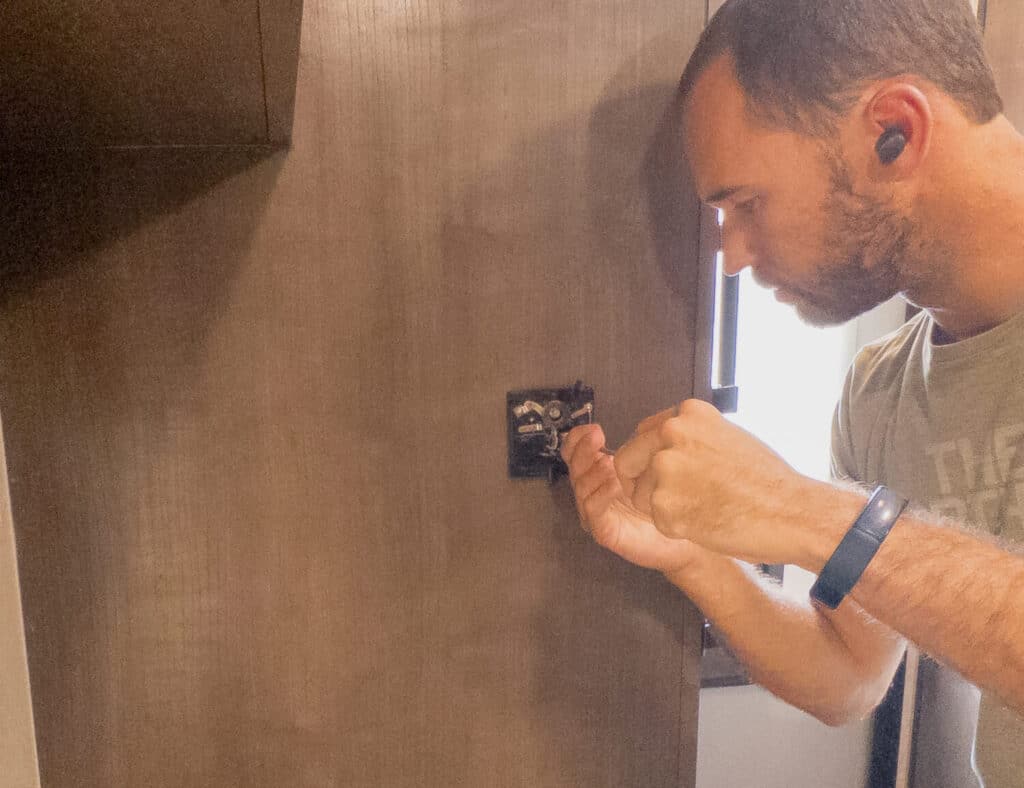
Photo by Camping World
Like most RV appliance replacements, the exact method for replacing parts will depend on your RV and the design of the part you’re replacing. Still, here’s the overview of the process:
- Remove the thermostat’s fuse from your electrical control panel. This typically requires a gentle touch with needle-nose pliers. There should be no power to the thermostat when working on it.
- Remove the faceplate on the thermostat’s housing.
- Photograph the wiring connections for later reference.
- Loosen the wire connection screws and remove the wiring. This will typically require a small flathead screwdriver.
- Remove the thermostat housing screws holding it to the wall.
- Take the housing off the wall and gently pull the wiring through the back of the housing.
- Stow or throw away the old thermostat housing to avoid confusing it with your new unit.
- Carefully feed the wires through the housing of the new thermostat and arrange them according to their respective terminals. Use the photo you took earlier for reference.
- Connect each wire to the appropriate terminal and tighten the set screws. Gently pull each wire to ensure the set screws are properly tightened to prevent movement.
- Reattach the thermostat housing to the wall and reinstall the faceplate.
- Replace the thermostat’s fuse in your RV’s electrical panel. The thermostat’s display should immediately light up.
- Test the new thermostat.
As mentioned, the exact methods will differ, and the details required in each step will vary. Due to the integral role your thermostat(s) play in regulating your RV’s heating and cooling systems, we highly recommend trusting a certified RV technician to replace the broken unit. Call your local Camping World to schedule a service appointment today.
Technician Tip: If an upgrade to a more modern or feature-packed thermostat is required or desired, bear in mind that conversion kits may be required to match up the existing wiring and communications systems.
Can I Replace My RV Thermostat with Any Thermostat?
The thermostat replacement you choose must be designed for RV electrical systems, which don’t provide the same power source used by most residential thermostats. They must also be designed for the exact make and model of your RV’s air conditioner and furnace. They are not interchangeable.
Can You Put a Smart Thermostat in an RV?
So long as it’s designed for RV use, you can install a smart thermostat in your unit. However, these won’t be off-the-shelf products from a big box store. They’ll only work if specifically made for use with the A/C and furnace in the RV by the A/C manufacturer.
One example is the Easy Touch by Micro Air aftermarket smart thermostat, which promises to “replace all major brand A/C thermostats without losing any features.” Beware that this is a claim and not a guarantee, and any use of aftermarket components will generally void any existing warranties.
That’s why we recommend trusting the diagnosis, repair, and, if necessary, replacement of your RV thermostat to a certified RV technician.
Can You Use a House Thermostat in an RV?
Standard residential thermostats cannot be installed in an RV because they require a source of 24-volt AC power that isn’t present in RV electrical systems. RV thermostats must function whether or not your unit is plugged into shore power (AC). That’s why they’re designed to work with 12-volt house battery power.
Camping World’s Best Selling RV Thermostats
Whether you’re looking for a thermostat replacement or you’re ready to upgrade, here are three of our top-selling RV thermostat models:
Dometic Comfort Control Center
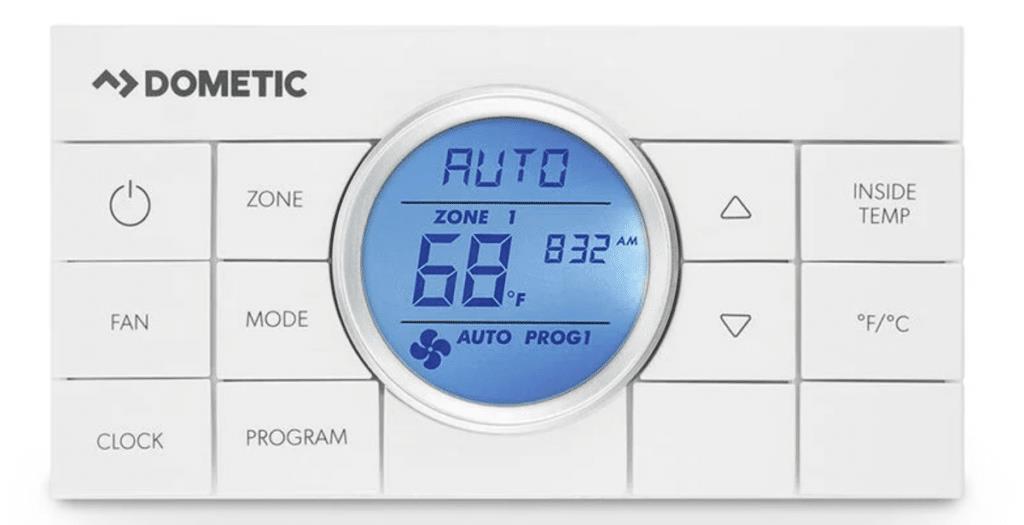
Photo by Camping World
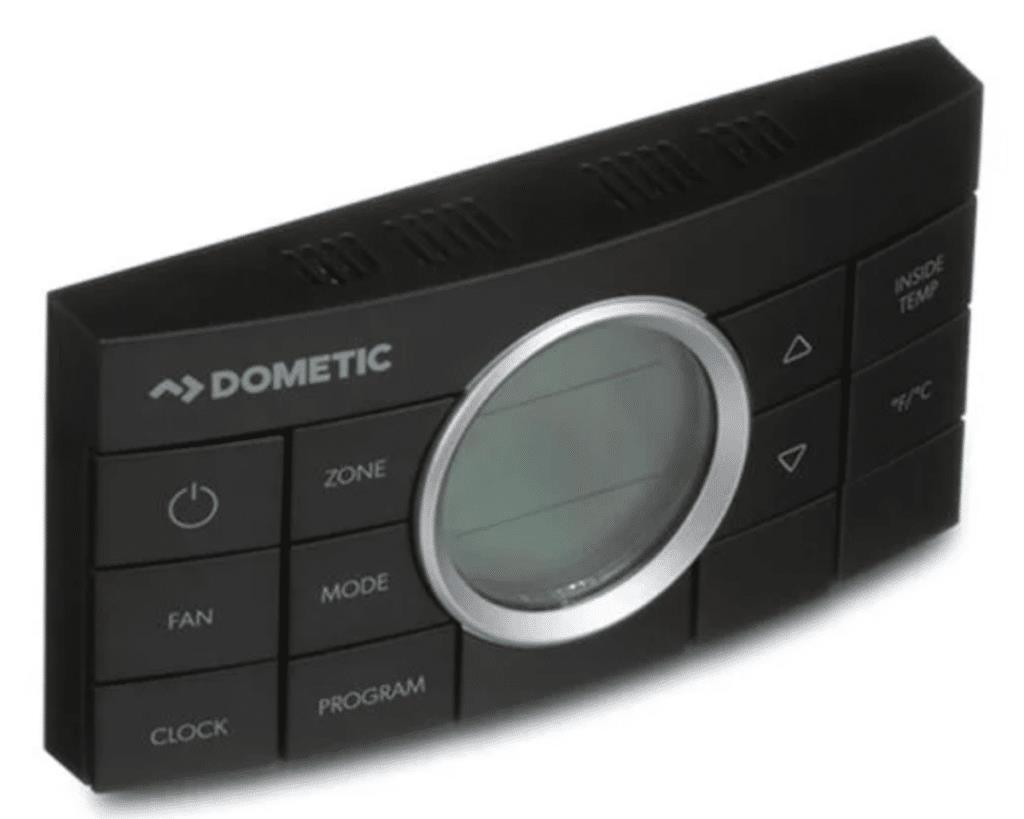
Photo by Camping World
Type: Digital
This thermostat is designed for use with compatible air conditioners in multi-room RVs with up to four cooling zones. It’s designed to sync with remote sensors in each zone to receive feedback in order to maintain your desired temperature.
Check the pricing and availability of the Dometic Comfort Control Center in white.
Or see if the black model better suits your RV’s interior decor.
Dometic Standard Single Zone Thermostat
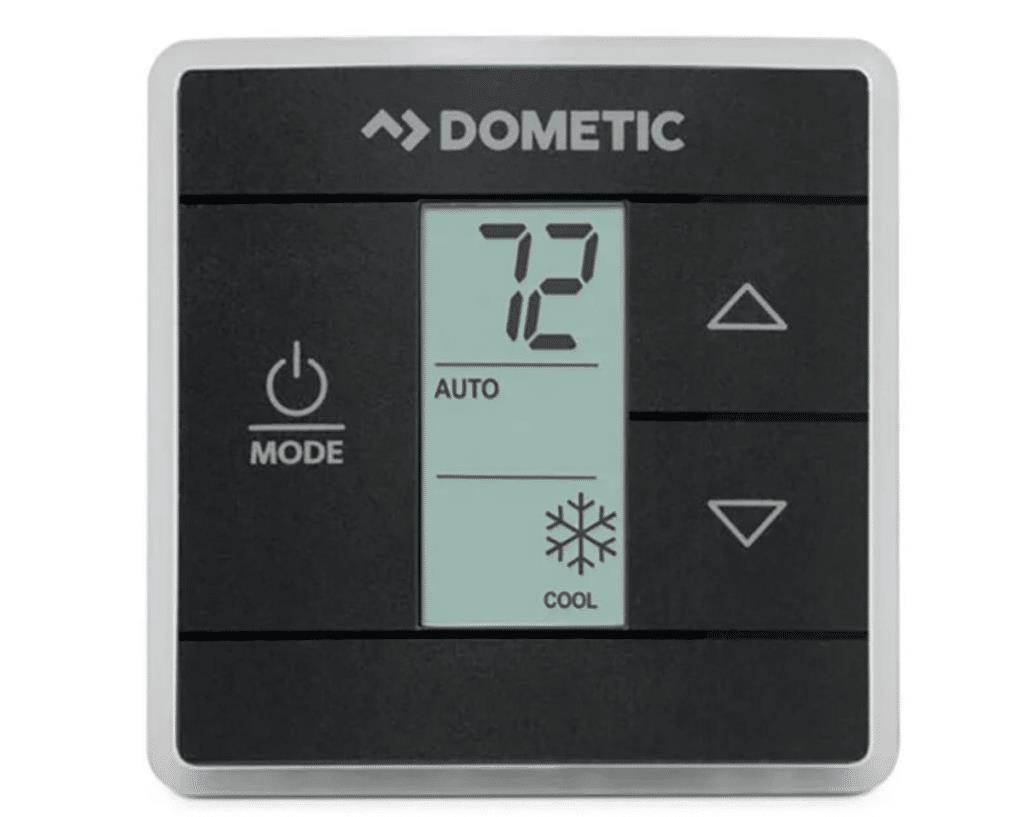
Photo by Camping World
Type: Digital
This Dometic thermostat is best for smaller campers with a single cooling zone. It’s compatible with ducted and non-ducted rooftop air conditioners. It features optional Bluetooth technology, allowing you to operate it remotely from the Dometic app on your Apple or Android device.
See the full list of specs for this Dometic thermostat.
Dometic Analog Thermostat
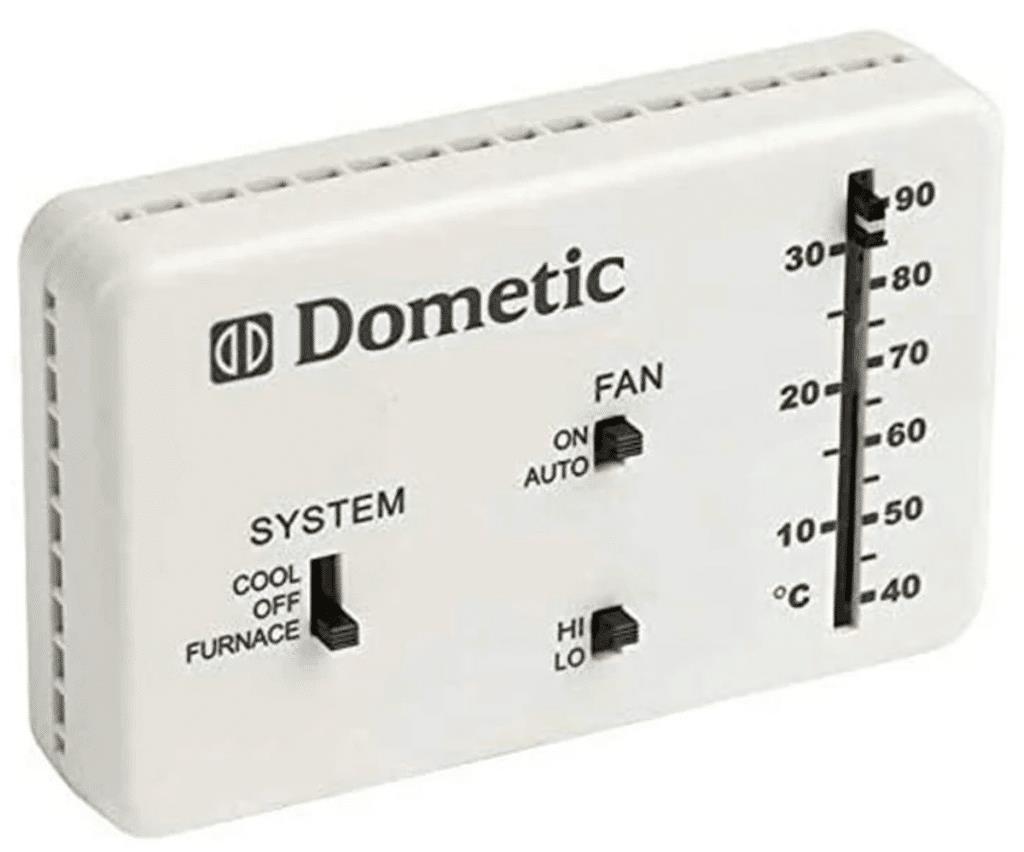
Photo by Camping World
Type: Analog
This Dometic analog thermostat is a direct replacement for the Duo-Therm 3106995.032 Thermostat. It works to control your air conditioner and furnace but must be used in partnership with a 3107541.009 Control Relay.
Learn more about this analog RV thermostat.
A working thermostat is integral to your RV’s ability to maintain your desired temperature. Here are a few more resources to help you stay comfortable on your next camping trip:
- How to Keep An RV Cool Without AC
- How to Manage Condensation and Moisture in an RV
- Keeping Your RV Furnace in Good Working Order
- This Simple Tool Will Improve the Performance of Your RV Air Conditioner
What questions do you have about RV thermostats? Let us know in the comments below.
The post Everything You Need to Know About Your RV Thermostat appeared first on Camping World Blog.
By: Tucker Ballister
Title: Everything You Need to Know About Your RV Thermostat
Sourced From: blog.campingworld.com/learn-to-rv/everything-you-need-to-know-about-your-rv-thermostat/
Published Date: Mon, 02 Oct 2023 08:00:00 +0000
---------------------------------------------
 CampingSurvivalistHuntingFishingExploringHikingPrivacy PolicyTerms And Conditions
CampingSurvivalistHuntingFishingExploringHikingPrivacy PolicyTerms And Conditions
